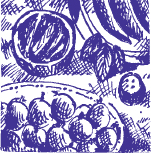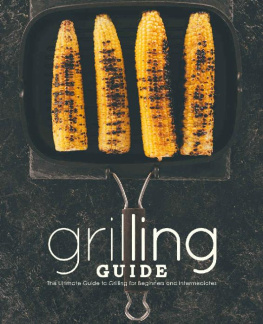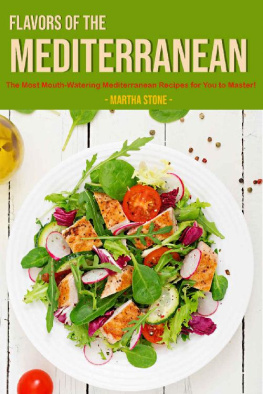This edition published by Grub Street, 2003
The Basement, 10 Chivalry Road, London SW11 1HT Copyright this edition Grub Street 2003
First UK impression 1995
First published by Editions de laube, France
English language translation copyright Heather Maxwell 1995
Design and jacket illustration Nicci Walker
Typesetting by Pearl Graphics, Hemel Hempstead
Printed and bound by Biddles Ltd, Guildford and Kings Lynn The moral right of the translator to be identified as the translator of this work is
hereby asserted. All rights reserved. No part of this publication may be reproduced, stored in a
retrieval system, or transmitted in any form or by any means, electronic, mechanical,
photocopying, recording or otherwise without the prior permission of the publisher. British Library Cataloguing in Publication Data
Kehayan, Nina
Essentially Aubergines
I. Title
641.65646 ISBN 1 904010 14 8
PRINT ISBN: 978 1 906502 86 7
EPUB ISBN: 978 1 909808 74 4 CONTENTS FOREWORD  Ever since it first came to this country in Elizabethan times, the aubergine has been a source of fascination. In striking contrast to our leeks and cabbages, carrots and cauliflowers, it seems to promise all the exotic charms of the Far and Middle East.
Ever since it first came to this country in Elizabethan times, the aubergine has been a source of fascination. In striking contrast to our leeks and cabbages, carrots and cauliflowers, it seems to promise all the exotic charms of the Far and Middle East.
Its bland and subtle flesh readily absorbs all the flavours of a Turkish spice market, while its texture can be rendered crisp and tender by frying, or melting and unctuous by baking. Those of us who were growing up just after the war remember the reappearance of the aubergine, and the excitement it engendered. Yet aubergines had been around, on and off, for some three hundred years. The first variety to reach our shores was probably the pearly-white egg-shaped form which gave rise to the name eggplant, by which it is still known in the US. By Victorian times, the white eggplant was believed to be unhealthy, but was still being cultivated for decorative purposes. Others grown with the same aim included a spectacular round jet-black globe called Perkin Black.
Nina Kehayan and her parents, her husband and his parents, like the wandering Jews of legend, made their separate ways across Europe after having been driven out of their homes in Russia, Poland and Armenia. They settled finally in France: Ninas family in Paris, her husbands in Marseilles. Eventually the young couple met, married, and made their home in Provence. I can understand the authors affectionate claim that Provence is the natural home of the aubergine, for it is her home also and she knows it far better than I, but for me it will always be associated most strongly with Turkey, for it was here that I first learnt to love it. The aubergine is very much a part of the Turkish cuisine, and fits naturally into their meal pattern, and way of life. The fierce dry heat of the brazier and grill is ideal for roasting aubergines, while the inimitable Turkish yoghurt blends exquisitely with them.
Aubergine dishes are legion in Turkey: smokey pures laced with garlic and sharpened with lemon juice; baked dishes of aubergines and tomatoes, layered with herbs; whole aubergines stuffed with minced lamb, or with rice and herbs, or burghul. Many years ago, at a dinner based on aubergines, in an old wooden house overlooking the Bosphorus, I first heard the story of the foreign guest who asked for a glass of water after his meal: just plain water, if you please, without aubergine Arabella Boxer ACKNOWLEDGEMENTS Most sincere thanks are extended to all those who kindly lent me their expertise whether it be artistic, linguistic or gastronomic, philosophical or technical. Many comments, suggestions and recipes were sent to me by readers of the first edition of this work and they have given me considerable assistance in producing this second edition. In particular, I wish to mention: Madame Marion Nazet, President of the La Couqueto Club in Marseilles, Monsieur Strak Ettarian, chef, Le Chiraz Restaurant, Marseilles, and the Tchakalian brothers, of the TCH oriental grocery in Marseilles. INTRODUCTION  When she left Calarasi, a Jewish town in her native Bessarabia nestled between the Ukrainian plains and the Carpathian mountains, young Tauba, her eyes the colour of autumn, took only a few belongings in her battered suitcase: a few garments sewn with her own hands, two or three photos of her parents and sisters, a handful of walnuts from her fathers attic tied in a cloth embroidered with her mothers initials. Whenever she felt homesick, she would take out this suitcase and search for the old familiar scents of her childhood.
When she left Calarasi, a Jewish town in her native Bessarabia nestled between the Ukrainian plains and the Carpathian mountains, young Tauba, her eyes the colour of autumn, took only a few belongings in her battered suitcase: a few garments sewn with her own hands, two or three photos of her parents and sisters, a handful of walnuts from her fathers attic tied in a cloth embroidered with her mothers initials. Whenever she felt homesick, she would take out this suitcase and search for the old familiar scents of her childhood.
It was the end of the Twenties. Moyshe had also abandoned his Jewish town far to the north of Calarasi, on the wide open plains of Poland. No walnuts for him, just a set of needles and a thimble to help him earn a living as a tailor with his nimble fingers in those far-off lands of his dreams, lands where the sun lingered at the end of the day before going to its rest. Years passed, years spent in and out of work, resident permits alternating with forced expulsions, until at last Tauba reached to the further reaches of Outer Europe: Lige to be exact. She was not lonely for long; many other young emigrants from Poland and Romania were arriving by various serpentine routes, one by one setting down their suitcases near hers, only too happy to find jobs in the fat, rich industrial plants, fat enough and rich enough to need workers such as them. provided the opportunity for Moyshe to meet Tauba.
Together they shared the new and exotic smells of the coalpits, together they explored the unfamiliar goy pleasures of fried chips. For Moyshe, it was Taubas graceful walk and her soft, sad eyes which caught his attention, while Tauba was attracted by her new friends elegance, so typically Polish, and by his fine bearing and high spirits. With Yiddish as their common language and Marxism as their shared creed, their first kisses set the seal on their promise to stay together until death separated them forever. Before long, however, they and their kind were no longer welcome on those wide Northern plains and settled on Paris as their new home. But the city of their dreams turned out to be a city of hard times. They had to face a daily battle for work, only relieved by the pleasure of restaurants and their fixed menus on pay-days; the misery of dingy hotels and of clandestine dawn departures, the arid apprenticeship in a new language.
Jeers and disdain they received were tempered by the joys of friendship, and then forgotten in their unshakeable faith in a better future and most of all, in the happiness of a first child. Like so many others, they lived through the terrible War, with its separations and its fears, the search for safe hiding places, balancing moments of boldness with long periods of waiting. When, at last, war-weary Europe succeeded in overcoming the monster it had created, Moyshe returned to Paris and swore to Tauba never to leave her alone again. That new promise brought its reward: a second child. Life became easier but wounds caused by the War could never be closed. Moyshe and Tauba would never see their parents nor most of their relatives again they had been killed, massacred, gassed.
Never having enjoyed a youth without sorrow and struggle, their faces were already marked by their sufferings and memories of childhood lost forever began to haunt their lives. One day Tauba returned from the market, smiling and radiant. Excitedly she pulled a strange treasure out of her basket: dark purple vegetables, long and swollen, with a prickly stem. Moyshe had never seen anything like them but Tauba was not paying attention, she was too busy inhaling a long forgotten smell from her homeland.
Next page





![Claudia Roden - Claudia Rodens Mediterranean: Treasured Recipes from a Lifetime of Travel [A Cookbook]](/uploads/posts/book/289768/thumbs/claudia-roden-claudia-roden-s-mediterranean.jpg)





 Ever since it first came to this country in Elizabethan times, the aubergine has been a source of fascination. In striking contrast to our leeks and cabbages, carrots and cauliflowers, it seems to promise all the exotic charms of the Far and Middle East.
Ever since it first came to this country in Elizabethan times, the aubergine has been a source of fascination. In striking contrast to our leeks and cabbages, carrots and cauliflowers, it seems to promise all the exotic charms of the Far and Middle East. When she left Calarasi, a Jewish town in her native Bessarabia nestled between the Ukrainian plains and the Carpathian mountains, young Tauba, her eyes the colour of autumn, took only a few belongings in her battered suitcase: a few garments sewn with her own hands, two or three photos of her parents and sisters, a handful of walnuts from her fathers attic tied in a cloth embroidered with her mothers initials. Whenever she felt homesick, she would take out this suitcase and search for the old familiar scents of her childhood.
When she left Calarasi, a Jewish town in her native Bessarabia nestled between the Ukrainian plains and the Carpathian mountains, young Tauba, her eyes the colour of autumn, took only a few belongings in her battered suitcase: a few garments sewn with her own hands, two or three photos of her parents and sisters, a handful of walnuts from her fathers attic tied in a cloth embroidered with her mothers initials. Whenever she felt homesick, she would take out this suitcase and search for the old familiar scents of her childhood.